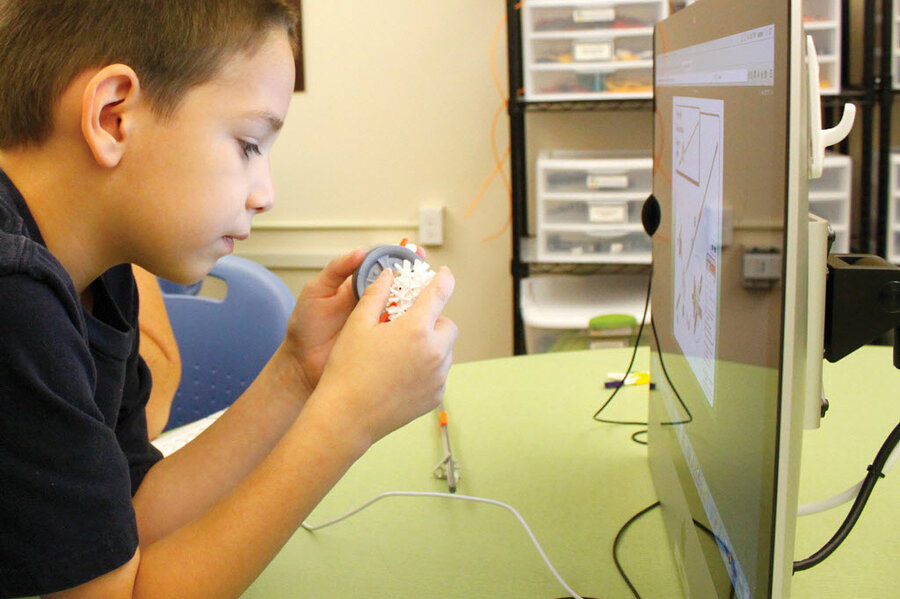Why 'homework gap' may pave way for universal Internet access in schools
Loading...
For some students and their families, homework can seem like a nuisance, fueling calls to ban work outside the classroom entirely. But as schools increasingly use online resources and other technology in the classroom, the burden for students without high-speed Internet access at home is particularly intense, often leaving them unable to complete the required assignments.
Known as the “homework gap,” the issue has been drawing particular attention from federal regulators, with Federal Communications Commissioner Jessica Rosenworcel calling it “the cruelest part of the digital divide.”
“When you bring technology into the classroom, you can do the lessons in the classroom, but to the extent that students become familiar with the material -- it has to be done outside of school,” says Deven Carlson, a political science professor at the University of Oklahoma.
Now, Congress has stepped in, with two lawmakers introducing a bill that would call for a national study on the issue, which has a particularly large scale impact on low-income and black and Hispanic students. Nationally, about five million households with school-age children lack broadband Internet access, a recent study by the Pew Research Center found.
The bill, introduced last Friday by Rep. Peter Welch (D) of Vermont and Rep. David McKinley (R) of West Virginia, was also endorsed by Ms. Rosenworcel, who has been particularly active in discussing the burden placed on students without Internet access. The proposal also pledges additional support for pilot programs to improve Internet access outside the classroom, which regulators say is desperately needed.
While just over 82 percent of households with school-age children have access to broadband Internet, the Pew Research survey found, about one-third of families with incomes under $50,000 did not. Minority students were similarly underserved, with 38.6 percent of black families and 37.4 percent of Hispanic families currently without broadband access, the researchers found.
Prof. Carlson says a push for universal broadband access – which has been a long term priority for the Obama administration – could have a large scale impact on how teachers are able to interact with students, as well as how they prepare for college and careers increasingly reliant on digital technology.
“It gives schools the flexibility to give assignments that are completely online, which is the reality in the workplace today,” he says. “Schools that serve low-income students are really limited right now.”
As broadband speeds have continued to increase over the past few years and consumers have begun using smartphones to go online, issues like the homework gap have become increasingly important, says John Horrigan, a senior researcher focused on internet and technology at Pew, who conducted the research.
“Our hope is that by putting the data out there, schools districts are more informed about the actions they take, whether they are actions to further education [about the issue], or to close this gap,” Mr. Horrigan says.
In a previous Pew survey on classroom technology, he noted some teachers said they were hesitant to assign homework that required going online because they worried their students might not be able to access it. Just 18 percent of teachers surveyed said all or almost all of their students had access to the technology they needed at home, the 2013 survey found.
Two key programs could help the FCC broaden Internet access, particularly in low-income households. One is the expansion of a Reagan-era program called Lifeline – which provide discounts on phone service to low-income households – to include broadband Internet service. The FCC also oversees the E-Rate program, which provides broadband Internet to schools and libraries; it began focusing on expanding Wi-Fi networks in 2014.
The Lifeline program, which was expanded in 2005 to include wireless phone services under the administration of former President George W. Bush, has proved somewhat controversial in recent years, with some Republican lawmakers introducing bills to stop Congress from funding it.
The new bill has also received broad support from educators, with representatives from the American Federation of Teachers, the National Education Association, the American Library Association and several superintendents’ groups also pledging their support in a letter to Congress.
But while universal broadband access seems to be a noble goal, bringing technology fully into the classroom, particularly in districts that serve large numbers of low-income students, has not been free of controversy.
Professor Carlson points to a much-discussed effort to provide an iPad for every student in the Los Angeles Unified School District. It would have cost $1.3 billion, but was cancelled this year amid claims of improper bidding on contracts, inconsistent Internet access and eventually little use of education software provided by industry giant Pearson.
For school districts concerned about how their students are adopting to schoolwork that increasingly embraces the use of technology, working more closely with families is a key consideration, some researchers say.
“While conversations about digital equity inevitably focus on students and their schools, homes are key sites for children's learning,” wrote Vikki S. Katz, Michael H. Levine and Carmen Gonzalez, who are affiliated with the Joan Ganz Cooney Center, a research lab founded by the non-profit that produces “Sesame Street,” in a recent commentary in Education Week.
They say teachers and administrators should focus on building close relationships with families of low-income and minority students, who were the focus of their research.
But Carlson says on the federal level, the Obama administration’s focus on universal Internet access in schools, through executive actions and partnerships with tech companies like the ConnectED initiative, is a step in right direction. Beyond universal Internet, how to best fit technology into the classroom will continue to be an ongoing challenge, he says.
“I think we’re at a phase [where] schools are taking different approaches, but I’m not sure that anyone’s really figured out what works.”







